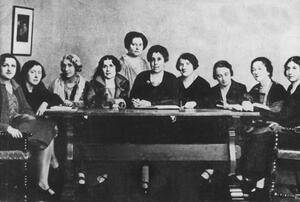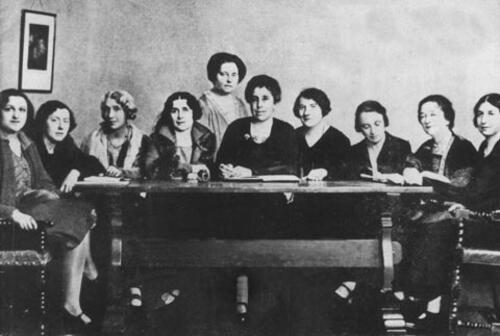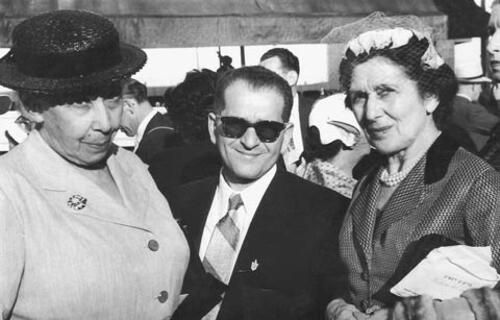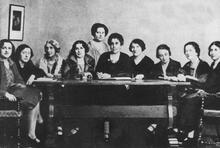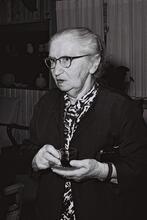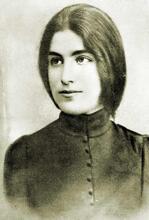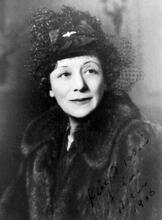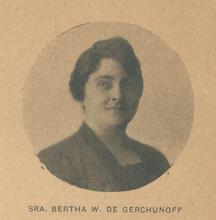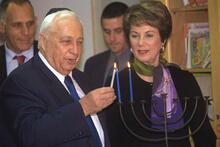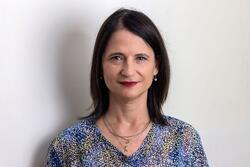Rebecca Sieff
Rebecca Sieff, the daughter of a wealthy Jewish family from Manchester, England, played an active role in two central social-historical movements: the struggle for women’s rights and the Zionist movement that eventually led to the establishment of the State of Israel. The fruits of Sieff’s activities can be seen to this day in many institutions both in Israel and abroad, most notably the Women’s International Zionist Organization, which Sieff co-founded.
Early Life and Education
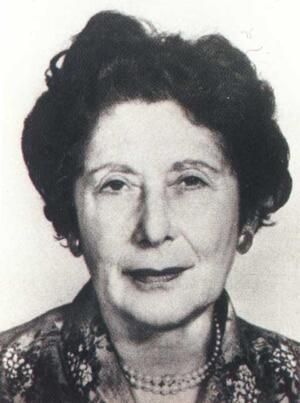
Rebecca Sieff played an active role in the struggle for women’s rights and the Zionist movement. She was one of the passionate women who, dissatisfied with the position allotted them by the Zionist leadership, established an independent women’s organization: WIZO, the Women's International Zionist Organization
Institution: WIZO
Rebecca Sieff (1890–1966), the daughter of a wealthy Jewish family from Manchester, England, played an active role in two central social-historical movements: the struggle for women’s rights and the Zionist movement that eventually led to the establishment of the State of Israel. The fruits of Sieff’s activities can be seen to this day in many institutions both in Israel and abroad.
Sieff’s father, Michael Marks (1864–1907), had fled to England from the pogroms of Russia in 1882, arriving in Leeds as a refugee. At first he earned a living as a peddler; within two years he opened his first stall in the city’s market. From these humble beginnings he developed what would become the retail empire of Marks and Spencer. His wife, Hannah (Anee Cohen, 1865–1917), was illiterate, so her signature does not appear on Rebecca’s birth certificate. The couple were married in a synagogue in Leeds in 1886.
Rebecca was the second of her parents’ five children—Simon (1888–1964) married Miriam Sieff, Miriam (1892–1975) married Harry Sacher, Mathilda (1895–1964), and Elaine (1902–1985). In 1894, when Rebecca was four years old, the family settled in Manchester, in a crowded apartment above the little store her father rented. The division of labor within the family was traditionally patriarchal: Hannah took care of the household and Michael widened his business interests; decision-making rested with the men. It became clear early on that Simon, talented at business, would inherit his father’s position in the family businesses. It seems that Rebecca accepted this and chose to direct her considerable talents and energies outside the narrow family circle.
As Marks and Spencer flourished and grew, the family’s quality of life improved and opportunities opened up for Rebecca. She attended the only local school thought suitable for daughters of the newly rich middle class: Manchester High School for Girls. The Jews of Manchester and its suburbs were drawn to the school by its undefined religious orientation: originally intended to serve pupils from a variety of Christian denominations, it was nevertheless perceived as a satisfactory solution for Jewish parents looking for a school for their daughters.
During Sieff’s school days the movement for women’s education was spreading. One of its aims was to make higher education available to women; Manchester University was part of this movement. In possession of a high school diploma, Sieff enrolled in the women’s section of the university, where she majored in English literature. At that time her future husband, Israel Sieff, was studying economics at the university; in 1910 they were married.
Jews were drawn to Manchester, the city of cotton and textiles; by the beginning of the twentieth century its Jewish community numbered 53,000, second in size only to that of London. A regional center of trade, culture, and politics, the city was known for its tolerance and liberalism. During this period the young couple laid the foundations of their future wealth.
Chaim Weizmann and Women’s Zionism
In 1904 Chaim Weizmann came to Manchester University as a lecturer in chemistry. He quickly built up a reputation as a brilliant scientist and an articulate public speaker. Within a few years he became the leader of the Zionist movement in England. His friends included not only prominent Jews but also powerful and influential non-Jews such as Charles Scott, editor of The Manchester Guardian, and Henry Steed of the London Times. A charismatic figure, Weizmann was surrounded by an admiring circle of young people, noted for their business talents, financial resources, and connections, all of which were used to forward the Zionist cause. Strong, energetic women such as Sieff, however, were dissatisfied with the position allotted them by the Zionist leadership. Conscious as they were of the gains made by the feminist awakening in England, which culminated in women’s enfranchisement, these women were disappointed by the tasks appointed them in the Zionist organization: fund-raising and similar activities. Many felt that they were being excluded from more significant involvement in the strategic planning needed for the birth of a country. This perceived belittlement discouraged them from seeking leadership roles in the Zionist Organization.
Prior to the outbreak of World War I, a number of women’s groups were established within the Zionist movement; one of them was B’not Zion, of which Sieff was a member. During the war Sieff collected funds for the Charity Fund for Polish Jewry and was among the founders of the Rehabilitation and Preparation Fund, a precursor of Keren Hayesod (founded in London in 1920). In 1918 Sieff was one of three women members of the Zionist Federation of Great Britain who were elected in their own right to the Council of the English Zionist Federation, rather than as representatives of certain women’s groups connected to the general Zionist Federation. The others were Romana Goodman and Vera Weizmann.
In 1918 women members of the Zionist Organization of England were enabled to set up their own organization, the Federation of Women Zionists (FWZ) in England and Ireland. From the proceedings of the first conference, it is clear that from the beginning the founders aimed at establishing an organization of Zionist women that would not be limited to Britain but would be international, and whose work would be directed at ensuring the welfare of women and children in Palestine. The founders of the new organization elected Rebecca Sieff as president, opened an office in London in February 1919, and formed committees for disseminating their ideas, for collecting clothing for orphans in Palestine, and for cooperation with the London branch of the Verband jüdischer Frauen für Kulturarbeit in Palästina (The Jewish Women’s League for Cultural Work in Palestine), an organization that had been established in The Hague in 1907, at the Eighth Zionist Congress, by wives of the Zionist leaders in Germany.
Touring Palestine
In April 1918, with the support of the British government, the Zionist Commission under the leadership of Chaim Weizmann arrived in Palestine; the other seven members represented the wartime allies and included David Eder and Israel Sieff. The committee’s mandate was to study the general situation in Palestine and prepare a recommendation to the British government of ways to apply the Balfour Declaration. In September 1919 Weizmann and Israel Sieff returned to England, while Edith Eder remained in Palestine with her husband. On Weizmann’s and Sieff’s return to England, Rebecca Sieff and Vera Weizmann visited Palestine in order to collect first-hand information on the situation of the Jews there. Joined by Edith Eder, they formed a Women’s Representative Committee whose aim was to plan a program for utilizing the funds which they hoped to raise for the benefit of women and children. The Women’s Committee traveled the length and breadth of Palestine during October and November 1919. They were shocked by the inhuman living conditions of the pioneers, and especially by those of the women pioneers; they decided that drastic measures were in order. In November 1919 Sieff wrote to her colleagues in the British Federation of Women Zionists; she and Vera Weizmann concluded that:
… the most essential piece of work which the Federation of Women Zionists—and indeed women Zionists all over the world—could undertake, is to take steps to create as soon as possible a school of domestic economy in Jerusalem.
Sieff emphasized two issues which became central in the activities of the new women’s organization: the establishment of an international Zionist women’s organization and the founding of a school for home economics in Palestine. (The latter proposal was reminiscent of the schools set up in England for Jewish women immigrants from Eastern Europe.)
It is worthwhile noting Vera Weizmann’s conclusions:
Mrs. Eder, Mrs. Sieff and I as we toured the country were very impressed by the hard work done in rebuilding Palestine by the devoted Halutzot, a new term at that time, for our pioneer working-women. But we were no less perturbed, and even appalled by the arduous physical conditions of their lives. Eager and energetic, as they were, for which they deserve every praise, they misinterpreted the concept of ‘equality’ between men and women. To our mind these enthusiastic, idealistic women were mortgaging their future motherhood and even risking their health for this ‘equality’ principle. They worked ten or twelve hours breaking rocks and stones for roadmaking and repairing, carrying heavy loads, performing superhuman tasks.
Their homes, bare and simple, were neglected: cooking was haphazard at best, and the result of their culinary efforts anything but satisfying: dietary standards were neither known nor taken into consideration at all. They and their menfolk snatched whatever food they could lay hands on.
Weizmann’s memoirs are infused with her traditional view of women’s and men’s roles and her criticism of the women pioneers’ desire for equality is not hidden. As a physician, Weizmann feared that the women pioneers’ ambition of taking an equal part in backbreaking physical work, resulting, as she believed, from a denial of women’s physical limitations, would cause serious damage to their health. At the same time, Weizmann knew that the women pioneers had no framework in which to prepare themselves for traditional women’s roles. She and Sieff thus came to the same conclusion: the young women-pioneers must be enabled to train for their future work, even if the latter were to be essentially traditional.
The Birth of WIZO
On their return home, the women decided to form a women’s organization, the purpose of which would be to fill the gaps and shortages that so disturbingly faced them when in Palestine. The goal of this women’s organization would be filling those gaps and shortages of which the women had become aware during their visit to Palestine. Sieff and Weizmann, wives of British Zionist leaders, held essentially traditional gender values and came to Palestine from a highly developed country. They were worried by what they saw as the Yishuv’s lack of practical interest in women’s need for training, which would prepare them to fulfill traditional women’s roles in the family household; such training in home economics, they believed, could utilize newly-acquired knowledge and technology.
Sieff saw no advantage in women’s achieving so-called full equality with men if that equality was defined in terms of physical labor since the limits of their physical strength, she believed, would sentence them to a second-class status. She therefore supported the traditional gendered division of labor within the family, in which the woman remained at home as mother and homemaker. She concluded, however, that in order to enable women to realize their full potential and take part in the building of a national homeland, women must be taught to use modern technologies. A framework for women’s vocational training must be established, and a woman suited to the challenge by background and training must be recruited to set up such a framework. Since not even one penny, Sieff wrote, had been allotted to this purpose by the Education Committee of the Zionist Commission, there was no extant program for training in home economics; not even one woman was involved in the Education Committee’s decisions. As citizens of England, a country in which the importance of training in home economics was already recognized, the British Zionist women could make a special contribution to the development of such desperately-needed programs in Palestine.
Sieff did not yet know that Hanna Maisel, the ideal candidate for establishing the training program, was already at work in Palestine. From a perusal of Sieff’s report of her visit to Palestine we can deduce that, although Sieff was not familiar with Maisel’s work, they had both reached the same conclusion: there was an urgent need of vocational training programs for the women pioneers then arriving in Palestine, in order to enable them to make a meaningful contribution to establishing the national home. The visit to Palestine was undoubtedly the catalyst leading to the decision to set up an international women’s organization. On their return to London Sieff and Weizmann apparently met Maisel, who shared with them her ideas about vocational training for young women. In a letter to the Organizing Committee of the Zionist Congress the women of the Federation suggested founding an independent international Jewish women’s organization. In his detailed response Leo Hermann, the organizational secretary, expressed support for the idea while positing a number of difficulties. The founding of the Women’s International Zionist Organization (WIZO) was tentatively scheduled for July 1920 in London, as part of the first Zionist Congress to be convened after World War I.
The most strident opponent of the establishment of a separate organization was Dr. Rosa Weldt Strauss, a representative from Palestine. Strauss argued that women should work within existing frameworks, rather than setting up a separate women’s organization. Sieff, on the other hand, contended that a separate women’s organization was a pragmatic necessity; in her experience, women had not succeeded in attaining influence in the Zionist movement, despite their enfranchisement. She did insist, however, that a Zionist women’s organization should not be identified with feminist activity; the former aimed to contribute to the building of a national home, while the latter was mainly concerned with broadening its own power.
For Sieff, an independent women’s organization would enable women to develop their organizational talents and professional skills, in order that their contribution to building the homeland in Palestine would complement, rather than compete with, the men’s contribution. Sieff believed that a separate organization would further this aim. Separate women’s organizations would enable the women, not only to further their own personal goals, but to contribute to the strengthening of the Zionist Yishuv. The question of whether women should establish separate organizations or work within the general (male-dominated) frameworks was to accompany women activists in all of the national frameworks set up prior to the founding of the State: political parties, the Agricultural Executive Center (Ha-Merkaz ha-Hakla’i), the Zionist Organization, the Histadrut. There was no definitive answer to this question; there were projects, however, such as agricultural training for women, whose success resulted from separate women’s organizations.
Move to London
In 1926 Rebecca and Israel Sieff and their four children Michael (1911–1988), Marcus (1913–2001), Daniel (1915–1932), and Judith (1921–1994) moved from Manchester to London. Sieff continued to serve as president of WIZO (1920–1966) and devoted the main thrust of her energies to projects for women’s agricultural training; she continued, moreover, to support the establishment of crêches and other schemes for women’s vocational training.
On Hitler’s rise to power in Germany, Sieff founded the Women’s Appeal Committee of the Central British Fund for German Jewry under the auspices of the FWZ. Uniting the efforts of all Jewish women’s organizations throughout Great Britain, this committee was responsible for the rescue of thousands of women and children from Nazi-dominated Europe. In addition, the committee was the first body to work with Recha Freier in sponsoring Youth Aliyah, which assisted young Jews in immigrating to Palestine, whether directly or by way of training centers in England. During World War II Sieff continued her activities in the Zionist movement while running a campaign for fuller parliamentary representation of women via the “Women for Westminster” organization which she actively sponsored. Sieff was in fact a central figure in the revived women’s movement; amongst the feminist issues for which she vigorously campaigned was equal compensation for civilian women injured in bombardments, equal rights in welfare assistance, equal rights before the law and similar causes.
At the end of World War II Sieff toured displaced persons’ camps in Germany and raised a protest against the British Mandatory government’s policy of preventing free immigration of Jews to Palestine. She appeared before the United Nations’ Special Committee On Palestine (UNSCOP), which held hearings in Palestine in 1947. The committee had been set by the United Nations to recommend solutions for the conflicts between Jews and Arabs who had been under the British Mandate for more than twenty-five years. Two spokeswomen for the Council of Jewish Women Organizations gave testimony: Rahel Katznelson in Hebrew and Rebecca Sieff in English. The memorandum they submitted to the committee in English was entitled “Jewish Women and the Upbuilding of Palestine.”
The State of Israel and Legacy
After the establishment of the State of Israel in 1948, Sieff made aliyah and resided in Tel Mond; her husband continued to reside in England. As president of WIZO she continued to run the organization’s wide-ranging activities, which the arrival of hundreds of thousands of immigrants in the 1950s made more vital than ever. In 1957 terrorists from Sinai attacked Sieff’s home, murdering the gardener; Sieff refused to move out of her house. In 1960 the Order of the British Empire was bestowed on Sieff by the British government. In 1963 Sieff retired from her managerial position in WIZO. She died on January 8th, 1966, a few days after her husband was awarded a lifetime peerage. Rebecca Sieff is buried in Tel Mond; Sieff Hospital in Safed now bears her name.
“Lady Sieff, Noted British Philanthropist, Dies at Her Home in Israel.” Jewish Telegraphic Agency. Tel Aviv: January 10, 1966.

